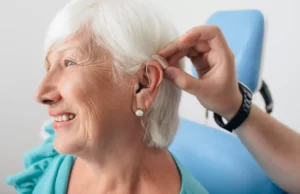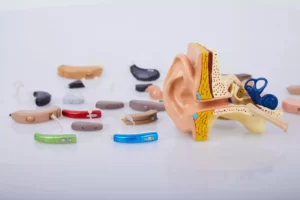Audiology Services -
Hearing Aids
Home | Treatments | Ear, Hearing Loss & Audiology | Hearing Aids
What Are Hearing Aids?
In spite of the great variety of types, designs and technical features, hearing aids can all be described as small, wearable electronic devices which enable a person to hear sounds better and understand speech more clearly, providing an overall improvement in communication ability.
How Do Hearing Aids Work?
Almost all types of hearing aids work/function in a similar way even though the outcome may be different for each person.
Firstly, sound is taken in through a miniature microphone where the sound is converted into an electronic, digital signal. Secondly, the signal is processed, boosted and modified to meet the needs of the user’s hearing loss. Finally, a receiver (miniature loudspeaker) sends the processed sound through the type of ear-fitting appropriate for your hearing aid system.
The audiologist who tests your hearing will discuss whether and what type of hearing aids would help based not only on your hearing loss but also on your lifestyle needs. Importantly, if you have hearing loss in both ears as most people do, you should expect to use two hearing aids; one hearing aid is almost always inadequate.
How Will I Feel Wearing A Hearing Aid?
 It takes time to get used to new hearing aids, and you will probably need to have them fine-tuned them once or more after you’ve had some experience with them. It’s quite normal for changes to be made after fitting as everyone is an individual and usually benefits from hearing aids being as personalised as possible.
It takes time to get used to new hearing aids, and you will probably need to have them fine-tuned them once or more after you’ve had some experience with them. It’s quite normal for changes to be made after fitting as everyone is an individual and usually benefits from hearing aids being as personalised as possible.
All digital hearing aids have different settings for different environments, like in a group, one-to-one conversation, in a quiet room or in noisier places. Make sure that your audiologist explains all your options when they fit your hearing aids and always remember that they are your hearing aids, programmed to meet your individual needs. For patients who use mobile phones frequently, some hearing aids even have Bluetooth connections so that your mobile phone can connect wirelessly to your hearing aids.
What Are The Different Types Of Hearing Aids?
 There are many different types and brands of hearing aids. The right kind for you will partly depend on your hearing loss, but there are other things to think about, too. For example, some people like to let others know about their hearing loss – or make a fashion statement – with a clearly visible aid. Others prefer a more discreet fitting that few will notice. It’s a personal choice.
There are many different types and brands of hearing aids. The right kind for you will partly depend on your hearing loss, but there are other things to think about, too. For example, some people like to let others know about their hearing loss – or make a fashion statement – with a clearly visible aid. Others prefer a more discreet fitting that few will notice. It’s a personal choice.
- A behind the ear (BTE) aid has two parts: the main part goes behind your ear. This is connected by a thin, clear tube to an ear-fitting that sits inside your ear canal. Some ear-fittings are made individually from ear impressions but many people now use small eartips not made individually but which fit very comfortably.
- A receiver in the canal (RIC) aid is like a BTE aid but smaller. An almost invisible wire connects the hearing aid to a receiver (tiny loudspeaker) fitted within the ear-fitting sitting in your ear canal.
- An in the ear/canal (ITE/ITC) aid sits completely within your outer ear (ITE) or just inside your ear canal (ITC).
- A completely in the canal (CIC) or invisible in the canal (IIC) aid goes deeper into the ear canal, making it nearly or wholly invisible. This is the most discreet kind of hearing aid but such tiny hearing aids may have hearing limitations for you.
How Do You Control Hearing Aid Settings?
Some hearing aids have controls you can use, some automatically vary their settings depending on the environment you are in and others can be adjusted using a hand-held remote control or through an app on your smartphone. Your preferences and different options will be discussed with you beforehand to help ensure that you make fully informed and shared decisions.
How Do You Choose The Right Hearing Aid?
There are so many different hearing aid systems that you should be confident that there are hearing aids which are right for you. However, there are a lot of things to be considered.
Not all providers can offer you every type of hearing aid. Some providers may have arrangements with particular manufacturers. Most providers offer a choice based on your personal needs and preferences.
Adjusting To New Hearing Aids
It can take up to three months to get used to new hearing aids. What you experience will depend on your hearing loss, your lifestyle needs and how much you wear your hearing aids.
Your brain will begin to register sounds that it has not heard well for some time. So you might feel tired by listening or overwhelmed by new noises. But, as you carry on using your new hearing aids, your brain learns to recognise the new sounds and they become more acceptable. It’s important to keep going and persevere,
What Is The Cost Of Hearing Aids?
The cost of hearing aids and professional services from a can vary a lot, depending on the technology, fitting style, accessories and your individual needs. Please contact us for further details.
References:

